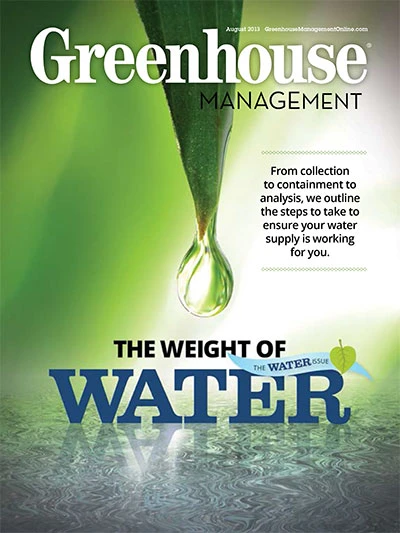 |
Rainwater harvesting isn’t just for gardeners anymore. Growers are putting large-scale, commercial systems in place to ensure their water resources stay plentiful without having to deal with all the red tape that inevitably comes with water restrictions from local municipalities and states.
Rainwater harvesting (RWH) is a method of collecting rainwater from the roofs of buildings or other catchment surfaces and sending it to storage for future use. Because rainwater is as yet a free resource and typically one of high quality and nutrition, growers are seeing benefits to installing harvesting systems.
Installing a system What’s a better structure for collecting rainwater than a commercial greenhouse? With high, angled roofs and gutter systems already in place — not to mention existing retention ponds at many locations and irrigation systems at the ready to use this high-quality water source — rainwater harvesting makes perfect sense for commercial horticulture.
Rainwater collection systems vary depending on the site, but they typically involve using a gutter system from building roofs to collect in above- or below-ground storage barrels or cisterns. From there, growers can use an infrastructure of pumps and pipes to deliver water to irrigation systems.
Storage volume is a balance between local-site environmental conditions, project budget and overall water-supply goals. Properly balancing demand with collection potential will offer longer-term success with your rainwater system.
In selecting a cistern, growers should consider the following:
- Required or desired storage capacity.
- Type of cistern: above or below ground, wood, steel, PE, concrete.
- Preferred diameter and height. Are there restrictions to size? Measure the area available for tank installation.
- Specific project or delivery location information and instructions.
- Desired schedule for delivery or completion.
- Pipe sizes. Inlet, outlet, overflow drain and location.
- Accessories. It’s more cost-effective to purchase accessories at the same time you order the tank. Consider tank access and ladders, water level indicators and controls.
- Snow loading or special wind conditions.
Rainwater is essentially purified water from the sky in the form of condensed water vapor, making it a very high-quality water source. But once it hits the catchment surface and flows into the drainage pipes, it can become contaminated with biological, chemical and physical properties. Reducing these contaminants through screening, filtering and water treatment is key to maintaining good water quality for use as greenhouse irrigation water.
 |
 |
RWH evaluations
If you are unsure about whether or not installing a rainwater harvesting system makes sense for your operation, ask another grower. According to Paul Fisher, associate professor and extension specialist at University of Florida, some big players in horticulture are currently in the process of installing collection systems.
“Rainwater collection systems are absolutely viable for commercial greenhouse operations,” Fisher says. “A very good example of a large-scale greenhouse that recently completed installation of such a system is Metrolina Greenhouses in North Carolina. There are other growers setting themselves up to this as well. Lucas Greenhouses in New Jersey is in the process of building all the infrastructure.”
Fisher adds that in his own state of Florida, Agri-Starts is in the process of building a rainwater collection system.
“It is risk management,” Fisher says. “A rainwater-harvesting system allows you to be independent of regulators, have your own water system and be less vulnerable to restrictions. It’s getting harder for growers to put down new wells and compete with other aspects of society for water, especially potable water for drinking. Plus, rainwater is very good quality, so it makes great sense.”
Benefits and incentives
With all of the incentive programs in place nationwide, it’s likely your system could be funded with a grant, and the benefits don’t stop there. For growers interested in LEED certification through the U.S. Green Building Council’s Leadership in Energy and Environmental Design program, water use reduction is a critical element. Rainwater harvesting is a simple, low-cost solution that can offer further savings once installed. Learn more by visiting the USGBC web site at www.usgbc.org.
To learn about incentives offered in your state, visit the Harvest H2O site at www.harvesth2o.com. Some states, like Ohio, don’t offer any incentives; however, in states like California, Florida and Colorado where water is at a premium and growers have to compete for water due to heavy restrictions, incentives and grants for RWH are abundant.
Michael Kovalycsik is national sales and marketing director at Delta T Solutions.

Explore the August 2013 Issue
Check out more from this issue and find your next story to read.
Latest from Greenhouse Management
- Anthura acquires Bromelia assets from Corn. Bak in Netherlands
- Top 10 stories for National Poinsettia Day
- Langendoen Mechanical hosts open house to showcase new greenhouse build
- Conor Foy joins EHR's national sales team
- Pantone announces its 2026 Color of the Year
- Syngenta granted federal registration for Trefinti nematicide/fungicide in ornamental market
- A legacy of influence
- HILA 2025 video highlights: John Gaydos of Proven Winners





